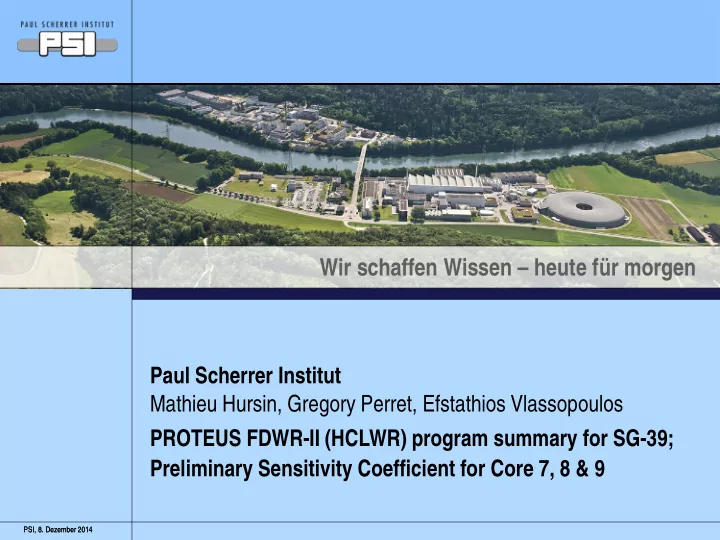

Wir schaffen Wissen – heute für morgen Paul Scherrer Institut Mathieu Hursin, Gregory Perret, Efstathios Vlassopoulos PROTEUS FDWR-II (HCLWR) program summary for SG-39; Preliminary Sensitivity Coefficient for Core 7, 8 & 9 PSI, 8. Dezember 2014 PSI, 8. Dezember 2014
Outline FDWR Experiments at PROTEUS Computational Models of FDWR Experiments • Selected C/E values for interesting configurations • Spectrum information Preliminary Sensitivity Results Conclusion and where to go from here NEA, 13.05,2014 Seite 2
FDWR-II – Experimental Configurations FDWR Phase II •From 1985 to 1990 in PROTEUS reactor •PROTEUS is a driven system whose test zone contains the FDWR lattices •UO 2 /PuO 2 pellets with 11% PuO 2 •Pu(8/9/0/1/2): 1%, 64%, 23%, 8%, 4% •Fuel diameter: 8.46mm •Fuel total height: 84 cm •2 axial blankets: •Udep. 0.224w% 235 U •28-cm high each •Several moderation conditions •Two triangular pitches • Different moderators (water, downterm, air) PSI, 8. Dezember 2014 Seite 3
FDWR-II – Measurement types • K∞ measurements •Using axial and radial bucklings •Using compensation methods with auto-rod and a 252 Cf sources • Reactivity effects of • Void volume • Moderator volume •Absorber rods PSI, 8. Dezember 2014 Seite 4
FDWR-II – Measurement types Spectral index measurements (core 7) •F5/F9 ~0.91 F1/F9 ~ 1.68 •F8/F9 ~1.14e-2 C2/F9 ~ 1.12 •C8/F9 ~7.8e-2 •Typical uncertainties F5: 1.8%, F8: 1.9%, F9:1.5%, C8: 1.8% Reaction rate radial and axial traverses PSI, 8. Dezember 2014 Seite 5
Spectrum Comparison NEA, 13.05,2014 Seite 6
FDWR-II – Calculation tools PSI • In the 80’s Cell calculations: WIMSD4 with the WIMS-1981 data library • Whole reactor calculations: ONEDANT (one dimension transport) • Macroscopic cross-sections generation: • • WIMSD4 (P0 transport corrected) DSNXSL XSLIB • In the 2010’s Master student started reanalysis with MCNP6 & SERPENT-v2 (2.1.15) • • Cell calculations for core 7,8 and 9 so far • Slow progress… Limited effort ~ 14 days • KfK • Cell calculations: KAPER4 with the G69P1V02 data library (69 Groups) • Whole reactor calculations: 2D DIXY2 diffusion and TWODANT transport codes • Macroscopic cross-sections with transport corrected P0 and P1, S4 TUBS • XS preparation: modified WIPRO, NJOY (ENDF/B-V, JEF-1), various DATUBS-nn • Cell calculations: SPEKTRA (various libraries) • Whole reactor calculations: DITUBS (2D diffusion, 35 groups) PSI, 8. Dezember 2014 Seite 7
Selected C/E values for interesting configurations Core 7, 8 and 9 are considered the most interesting • For their “soft spectrum” C/E Core 7 Core 8 Core 9 C/E Value Rel. unc. Abs. unc. Value Rel. unc. Abs. unc. Value Rel. unc. Abs. unc. C8/F9 1.007 1.80% 0.018 1.021 1.60% 0.016 0.989 1.70% 0.017 F8/F9 1.024 1.90% 0.019 1.003 1.81% 0.018 1.017 1.80% 0.018 F5/F9 1.017 1.50% 0.015 1.023 1.30% 0.013 1.023 1.50% 0.015 F1/F9 0.988 3.00% 0.030 1.011 3.00% 0.030 0.987 5.00% 0.049 C2/F9 1.044 3.01% 0.031 1.132 3.00% 0.034 1.035 3.02% 0.031 No obvious bias , except maybe for Pu-242 capture in Core 8 (~ 3.8 std). Need community feedback to understand potential interest for data assimilation NEA, 13.05,2014 Seite 8
Total k-eff sensitivities Sensitivity of k-eff Total sensitivity (and uncertainty) for core 7, 8 and 9 SERPENT and MCNP6 return consistent results for core 7 Configuration Core 7 Core 8 Core 9 Code MCNP6 SERPENT MCNP6 MCNP6 Isotope reaction sensitivity rel. unc. sensitivity rel. unc. sensitivity rel. unc. sensitivity rel. unc. Pu-239 fission 0.3746 0.2% 0.3679 0.2% 0.4455 0.1% 0.3845 0.2% Pu-239 total + sab 0.2244 0.6% 0.2178 0.6% 0.4053 0.3% 0.2588 0.6% U-238 capture -0.1744 0.2% -0.1769 0.2% -0.2654 0.2% -0.2055 0.2% Pu-239 capture -0.1493 0.2% -0.1505 0.2% -0.0380 0.2% -0.1268 0.3% U-238 total + sab -0.0885 3.3% -0.0922 3.3% -0.2245 1.7% -0.1197 3.4% Pu-241 fission 0.0801 0.4% 0.0789 0.4% 0.0713 0.3% 0.0844 0.4% U-238 fission 0.0743 0.5% 0.0754 0.5% 0.1150 0.3% 0.0839 0.6% Pu-240 capture -0.0679 0.4% -0.0674 0.4% -0.0141 0.3% -0.0507 0.6% Pu-241 total + sab 0.0640 0.6% 0.0627 0.6% 0.0673 0.4% 0.0705 0.7% Pu-240 total + sab -0.0512 1.2% -0.0514 1.2% 0.0184 0.7% -0.0311 2.4% NEA, Feb. 18-19, 2010 Seite 9
Sensitivity per unit lethargy [1] For selected (arbitrary) nuclide-reaction pairs of Core 7 SERPENT and MCNP6 return consistent results Relatively low number of neutron histories • Default number of latent generation for MCNP6, 15 for SERPENT-v2 • NEA, Feb. 18-19, 2010 Seite 10
Sensitivity per unit lethargy [2] For selected (arbitrary) nuclide-reaction pairs of Core 7 SERPENT and MCNP6 return consistent results Relatively low number of neutron histories • Default number of latent generation for MCNP6, 15 for SERPENT-v2 • NEA, Feb. 18-19, 2010 Seite 11
Sensitivity per unit lethargy [3] For selected (arbitrary) nuclide-reaction pairs of Core 7 SERPENT and MCNP6 return consistent results in the fast energy range, issue at lower energies Relatively low number of neutron histories • Default number of latent generation for MCNP6, 15 for SERPENT-v2 • NEA, Feb. 18-19, 2010 Seite 12
Conclusion Re-analysis of FDWR experiments at PROTEUS with modern modelling tools has started Limited resources • Cell models only • Preliminary results were presented • For the considered core configurations, no obvious bias Consistent sensitivity information were generated with SERPENT-2 and MCNP6 Dissemination of information is the next step Will not be for free • At least the cost for in-house re-analysis should be paid for. • The data itself may or may not go for free. • NEA, 13.05,2014 Seite 13
Recommend
More recommend